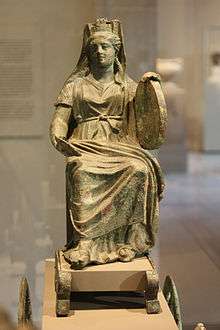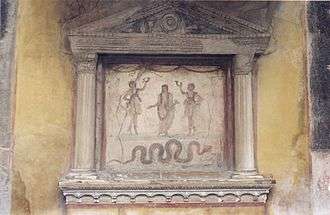Tutelary deity
A tutelary (/ˈtutlˌɛri/ or /ˈtjutlˌɛri/) (also tutelar) is a deity or spirit who is a guardian, patron, or protector of a particular place, geographic feature, person, lineage, nation, culture, or occupation. The etymology of "tutelary" expresses the concept of safety and thus of guardianship.
In late Greek and Roman religion, one type of tutelary deity, the genius, functions as the personal deity or daimon of an individual from birth to death. Another form of personal tutelary spirit is the familiar spirit of European folklore.[1]
America
Asia

- Chinese folk religion, both past and present, includes a myriad of tutelary deities. Exceptional individuals may become deified after death. Guan Yu is a well-known tutelary. See City God (East Asia) and Tudigong.
- In Hinduism, tutelary deities are known as ishta-devata and Kuldevi or Kuldevta. Gramadevata are guardian deities of villages. Devas can also be seen as tutelary. Shiva is patron of yogis and renunciants. City goddesses include:
- Kuladevis include:
- In Korean shamanism, jangseung and sotdae were placed at the edge of villages to frighten off demons. They were also worshiped as deities.
- In Philippine animism, Diwata or Lambana are deities or spirits that inhabit sacred places like mountains and mounds and serve as guardians.
- * Maria Makiling is the deity who guards Mt. Makiling.
- * Maria Cacao and Maria Sinukuan.
- In Shinto, the spirits, or kami, which give life to human bodies come from nature and return to it after death. Ancestors are therefore themselves tutelaries to be worshiped.
- Thai provincial capitals have tutelary city pillars and palladiums. The guardian spirit of a house is known as Chao Thi (เจ้าที่) or Phra Phum (พระภูมิ). Almost every Buddhist household in Thailand has a miniature shrine housing this tutelary deity, known as a spirit house.
- Tibetan Buddhism has Yidam as a tutelary deity. Dakini is the patron of those who seek knowledge.
Europe
Ancient Greece
Socrates spoke of hearing the voice of his personal spirit or daimonion:
You have often heard me speak of an oracle or sign which comes to me … . This sign I have had ever since I was a child. The sign is a voice which comes to me and always forbids me to do something which I am going to do, but never commands me to do anything, and this is what stands in the way of my being a politician.[2]
The Greeks also thought deities guarded specific places: For instance, Athena was the patron goddess of the city of Athens.
Ancient Rome

Tutelary deities who guard and preserve a place or a person are fundamental to ancient Roman religion. The tutelary deity of a man was his Genius, that of a woman her Juno.[3] In the Imperial era, the Genius of the Emperor was a focus of Imperial cult. An emperor might also adopt a major deity as his personal patron or tutelary,[4] as Augustus did Apollo.[5][6] Precedents for claiming the personal protection of a deity were established in the Republican era, when for instance the Roman dictator Sulla advertised the goddess Victory as his tutelary by holding public games (ludi) in her honor.[7]
Each town or city had one or more tutelary deities, whose protection was considered particularly vital in time of war and siege. Rome itself was protected by a goddess whose name was to be kept ritually secret on pain of death (for a supposed case, see Quintus Valerius Soranus).[8][9] The Capitoline Triad of Juno, Jupiter, and Minerva were also tutelaries of Rome.[10]
The Italic towns had their own tutelary deities. Juno often had this function, as at the Latin town of Lanuvium and the Etruscan city of Veii,[11] and was often housed in an especially grand temple on the arx (citadel) or other prominent or central location.[12] The tutelary deity of Praeneste was Fortuna, whose oracle was renowned.[13]
The Roman ritual of evocatio was premised on the belief that a town could be made vulnerable to military defeat if the power of its tutelary deity were diverted outside the city, perhaps by the offer of superior cult at Rome.[14][15] The depiction of some goddesses such as the Magna Mater (Great Mother, or Cybele) as "tower-crowned" represents their capacity to preserve the city.[16]
A town in the provinces might adopt a deity from within the Roman religious sphere to serve as its guardian, or syncretize its own tutelary with such; for instance, a community within the civitas of the Remi in Gaul adopted Apollo as its tutelary, and at the capital of the Remi (present-day Rheims), the tutelary was Mars Camulus,[17]

Tutelary deities were also attached to sites of a much smaller scale, such as storerooms, crossroads, and granaries. Each Roman home had a set of protective deities: the Lar or Lares of the household or familia, whose shrine was a lararium; the Penates who guarded the storeroom (penus) of the innermost part of the house; Vesta, whose sacred site in each house was the hearth; and the Genius of the paterfamilias, the head of household.[18] The poet Martial lists the tutelary deities who watch over various aspects of his farm.[19] The architecture of a granary (horreum) featured niches for images of the tutelary deities, who might include the genius loci or guardian spirit of the site, Hercules, Silvanus, Fortuna Conservatrix ("Fortuna the Preserver") and in the Greek East Aphrodite and Agathe Tyche.[20]
The Lares Compitales were the tutelary gods of a neighborhood (vicus), each of which had a compitum (shrine) devoted to these.[21][22] During the Republic, the cult of local or neighborhood tutelaries sometimes became rallying points for political and social unrest.
Germanic Europe
Austronesian
See also
| Look up tutelary in Wiktionary, the free dictionary. |
| Look up tutelar in Wiktionary, the free dictionary. |
- Animal spirit
- Dvarapala
- Eudaemon (mythology)
- Guardian angel
- Nagual
- National god
- Patron saint
- Power animal
- Tulpa
- Uay
References
- Riffard, Pierre A. (2008). Nouveau dictionnaire de l'ésotérisme. Paris, FR: Payot. pp. 114–115, 136–137.
- Plato. Apology of Socrates. 40 b.
- Nicole Belayche, "Religious Actors in Daily Life: Practices and Beliefs," in A Companion to Roman Religion (Blackwell, 2007), p. 279.
- Gradel, Ittai (2002). Emperor Worship and Roman Religion. Oxford University Press. pp. 104–105.
- Lipka, Michael (2009). Roman Gods: A conceptual approach. Brill. pp. 20–21.
- Gradel, Ittai (2002). Emperor Worship and Roman Religion. Oxford University Press. p. 116.
- Bernstein, Frank. "Complex Rituals: Games and processions in republican Rome". A Companion to Roman Religion. pp. 231 ff.
- de Martino, Marcello (2011). L'identità segreta della divinità tutelare di Roma. Un riesame dell' affaire Sorano. Settimo Sigillo.
- Rüpke, Jörg (2007). Religion of the Romans. Polity Press. pp. 132–133. (originally published in German 2001)
- Lipka. Roman Gods. pp. 23–24.
- Forsythe, Gary (2006) [2005]. A Critical History of Early Rome: From prehistory to the first Punic War. University of California Press. p. 128.
- Rüpke. Religion of the Romans. p. 132. who cites Macrobius. Saturnalia. 3.9.
- Meyboom, P.G.P. (1995). The Nile Mosaic of Palestrina: Early evidence of Egyptian religion in Italy. Brill. preface and p. 160. ISBN 978-9004101371..
- Lipka. Roman Gods. pp. 126–127.
- Ando, Clifford (2007). "Exporting Roman religion". A Companion to Roman Religion. Blackwell. p. 441.
- Lipka. Roman Gods. p. 123. who cites Lucretius. De rerum natura. 2.606–609.
- Derks, Ton (1998). Gods, Temples, and Ritual Practices: The transformation of religious ideas and values in Roman Gaul. Amsterdam University Press. pp. 100, 105, 108–109.
Local elites … were well aware of the mythological tales connected with the various Roman gods, and in the choice of a tutelary god for their civitas or pagus opted deliberately for a deity who, in all his aspects, was most in keeping with their own perception of the world.
- Warrior, Valerie M. (2006). Roman Religion. Cambridge University Press. pp. 28–29.
- Martial. Epigrams. 10.92. cited by Warrior. Roman Religion. pp. 29–30.
- Rickman, Geoffrey (1971). Roman Granaries and Store Buildings. Cambridge University Press. pp. 35, 52, 57, 313–314.
- Gradel. Emperor Worship and Roman Religion. p. 11.
- Palmer, Robert E.A. (2009). The Archaic Community of the Romans. Cambridge University Press. p. 81. ISBN 9780521077026.
- Bane, Theresa (1969). Encyclopedia of Demons in World Religions and Cultures. Jefferson, North Carolina. ISBN 9780786488940. OCLC 774276733.
| Wikimedia Commons has media related to Tutelary deities. |
| Look up tutelary deity in Wiktionary, the free dictionary. |